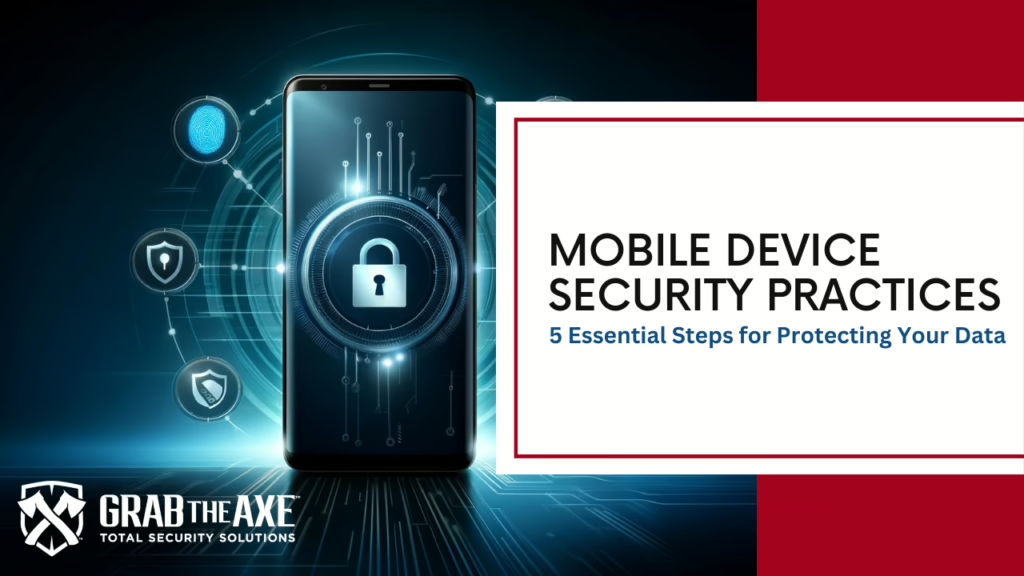Mobile Device Security FAQ
1. Why should I update my mobile device regularly?
Timely updates are crucial for mobile device security. They patch vulnerabilities that attackers could exploit. Outdated software and apps can leave your device susceptible to malware and data breaches. While updates might introduce changes to the user interface, these are minor inconveniences compared to the potential risks of using an outdated device.
2. What is the best way to manage my passwords on my mobile device?
Using a password manager is highly recommended. Password managers generate and store strong, unique passwords for all your accounts, eliminating the need to remember complex combinations. This protects you from password reuse, which is a common vulnerability. Apple devices offer a built-in password manager that is free and effective.
3. Is it safe to use public Wi-Fi on my mobile device?
Public Wi-Fi networks, especially those without password protection, pose a significant security risk. These networks can be easily compromised, allowing attackers to intercept your data. Avoid accessing sensitive information like bank accounts or personal emails while connected to public Wi-Fi. Consider using a VPN on your mobile device for an extra layer of security if public Wi-Fi is unavoidable.
4. How can I ensure the apps I download are safe?
Stick to downloading apps from trusted sources like the official app stores (Apple App Store or Google Play Store). While these stores have security measures, it’s still prudent to research apps before downloading them. Read reviews, check the developer’s reputation, and be wary of apps with limited downloads or suspicious permissions.
5. Should I keep Bluetooth enabled on my mobile device all the time?
It’s best practice to disable Bluetooth when not in use, especially in public places. Leaving Bluetooth on constantly increases the risk of unauthorized access or attacks. While accidental pairing is possible, attackers can exploit Bluetooth vulnerabilities to install malware or steal data.
6. What are some other essential mobile device security tips?
Be cautious about clicking links in emails or text messages:
- Verify the sender before clicking any links, as they could lead to phishing websites.
- Avoid clicking on suspicious pop-ups: These could be attempts to install malware on your device.
- Back up your data regularly: This ensures that you can recover your information in case of device loss or damage.
7. What should I do if my data is compromised?
If you suspect your data has been compromised, take immediate steps to secure your accounts. Change passwords, contact your bank or financial institutions, and report the incident to the appropriate authorities. Grab The Axe can assist with data breach response and provide guidance on mitigating the impact of a security incident.
8. How does Grab The Axe help businesses with security?
Grab The Axe is a security firm that offers comprehensive solutions for both digital and physical assets. They provide services like penetration testing, network security assessments, and data privacy compliance, along with physical security measures. Their expertise helps businesses identify and mitigate security risks, protecting them from modern threats.
Today, following essential Mobile Device Security Practices is crucial for anyone using a smartphone. Regular updates, like Apple’s latest iOS release, aim to improve device security. However, these updates alone aren’t enough; additional proactive steps are needed to protect your personal data against modern threat. Most smartphone users assume they are completely safe with these updates, not practicing safety while using their phones while also not being aware of just how easy it can be to hijack their device(s).
5 Essential Mobile Device Security Practices:
1. Timely Updates: A Key Mobile Device Security Practice:
Just like any other device, if an update is available for your software/firmware, download that update immediately. Updating your software and firmware promptly is one of the simplest Mobile Device Security Practices to safeguard against vulnerabilities. Devices become increasingly vulnerable if they are out of date; especially on a smartphone, even an outdated app can be the opening a malicious actor is looking for. Most users delay this update so as not to interrupt their work, but safety and security are paramount. Employers should understand that minor and short delays are for security reasons and encourage their employees to download the update. However, an average user may not want to update their device because they may not like forced changes of app layouts, such as the case for iPhone users and their photo album changes. While understandable, adjusting to these changes will be less of a headache as opposed to having your banking information compromised.
2. Secure Passwords: Using a Password Manager for Mobile Device Safety:
A password manager should also be used on your smartphone, not just your desktop or laptop. Strong password management is a cornerstone of effective Mobile Device Security Practices. Apple products now have a password manager implemented, and they are free; make sure to put it to good use. Doing so can help auto-generate strong passwords, allowing the user to easily change them (especially if you’re notified of a breach and one of your accounts is associated with the breach, if required by your employer, or if you’re simply doing so to be safer) and not having to remember those random strong passwords. Do not worry; you can access these passwords with ease. Some applications may require a master password to access your vault, but in the case of the Apple-implemented password manager, you can access it with a few taps and copy them if you need them.
3. Stay Safe on the Go: Avoid Public Wi-Fi for Better Mobile Security:
Avoiding public Wi-Fi is one of the fundamental Mobile Device Security Practices when in unfamiliar settings. Places such as airports, hotels, or coffee shops tend to offer free Wi-Fi that does not require a password to be accessed. While convenient and tempting, especially if your phone’s network happens to not work optimally while you’re in a certain area, avoid connecting to it with your mobile device. These open networks can be easily cloned, but also any traffic containing sensitive information that flows through an open network can be easily intercepted, even by the most novice of malicious attackers. These networks should be avoided entirely and only connected to as a last resort; even then, only connect to it if you have a VPN on your mobile device and make sure it is on prior to connecting to the public network. Yet you should still avoid doing anything such as logging into your bank, even if you are using a VPN.
4. Download Smartly: Stick to Trusted Apps for Mobile Device Security:
While any applications that are up for download on your phone’s app store are typically scanned and analyzed for any malicious coding, some applications may slip through the cracks and stay in the store for some time before they are caught and deleted. One of the essential Mobile Device Security Practices is to only download applications from trusted sources. Malicious characters may have altered the coding to include malware, compromising a device once it is downloaded by the user. It is also important to note that in smaller organizations with a smaller developer team, their application may be more prone to this practice, as well as being more prone to zero-day vulnerabilities, whether malicious code is inputted in their coding or not.
Explore our guide on mastering cyber security to enhance password protection and more.
5. Bluetooth Safety: Disabling Bluetooth When Not in Use:
Every modern device now has Bluetooth accessibility, not only your smartphone but also your car, headphones, keyboard, printers, and even TVs. Just like anything else, Bluetooth is prone to vulnerabilities, where an attacker can also connect to your devices via Bluetooth and allow them to install malware or backdoor access and potentially retrieve sensitive information. Disabling Bluetooth when not in use is among the best Mobile Device Security Practices, particularly in public places. While you may get notified on your phone of a device requesting to pair with yours, sure, you can simply reject it, but it is possible to accidentally accept it or blindly accept it if not mindful. Thankfully, an attacker would have to be within range to carry out this attack, but Bluetooth should still be disabled when not in use and when you’re out in public.
Secure Your Mobile Device: Final Thoughts on Essential Mobile Device Security Practices
It is important to be mindful and practice safety when using any device, especially your smartphone. Regardless of the latest updates and safety features, they’re rendered useless if you’re actively not updating your device in a timely manner, using weak and/or easy-to-guess passwords, especially since most people use the same password across the board or a minor variation of the same password. Accessing vulnerable public Wi-Fi networks, downloading any application without looking into them, and always leaving Bluetooth on, mainly when in public. Other practices should be followed, such as not clicking on random links received via email or text and clicking on random popups, especially if using a website that is not trusted. By adopting these Mobile Device Security Practices, you can help keep your device and personal data secure.
Read more about protecting your personal data in our Personal Data Privacy Strategies guide.
References
Concannon, M. (2024, January 3). The 7 Mobile Device Security Best Practices You Should Know for 2024. Retrieved from Ntiva: https://www.ntiva.com/blog/top-7-mobile-device-security-best-practices
Komando, K. (2023, February 26). Leaving your phone’s Bluetooth on is a bigger risk than you think. Here’s what you need to know. Retrieved from USA Today: https://www.usatoday.com/story/tech/columnist/komando/2023/02/26/leaving-your-phones-bluetooth-24-7-can-major-security-risk/11308150002/
Mobile Device Best Practices. (n.d., n.d. n.d.). Retrieved from NSA: https://media.defense.gov/2021/Sep/16/2002855921/-1/-1/0/MOBILE_DEVICE_BEST_PRACTICES_FINAL_V3%20-%20COPY.PDF
Renato, P. (2023, April 3). Mobile App Security Best Practices. Retrieved from Approov: https://approov.io/blog/mobile-app-security-best-practices
The 5 Mobile Device Security Best Practices You Should Know in 2022. (2022, December 15). Retrieved from OSIBeyond: https://www.osibeyond.com/blog/mobile-device-security-best-practices/





